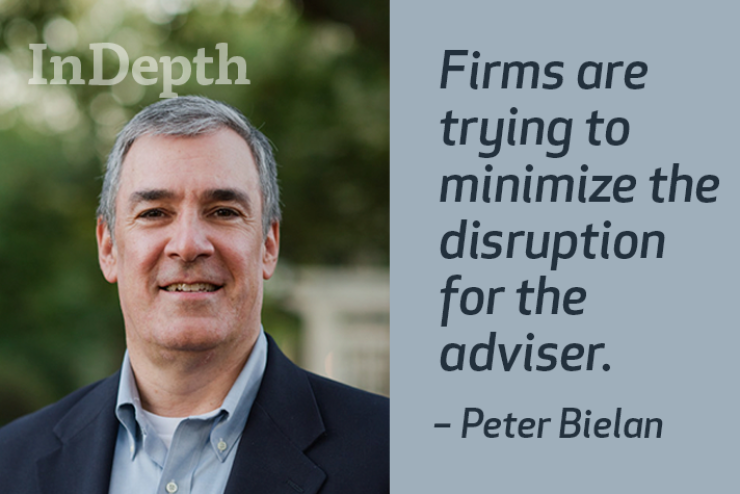Even if the fiduciary rule miraculously survives, bank wealth management firms are not about to upset the applecart when it comes to how their financial consultants are paid.
Most firms will likely continue to pay their advisers a salary plus commissions based on their production, according to Peter Bielan, managing principal at consulting firm Kehrer Bielan Research & Consulting.
"Firms are trying to minimize the disruption for the adviser," he said, adding that they fear losing their most valuable resource.
Still, advisers shouldn't sit back and not expect any changes. Commission rates on products within product sets will be "levelized" or made the same, and grid levels will be smoothed out to eliminate the conflicts of interest at the heart of the fiduciary rule.
"The guidance that the rule has put forth is that you don't want the grid levels to increase too dramatically," said Bielan. A grid level that goes from 32% to 35% isn't too significant a difference to influence an adviser inappropriately, but one that jumps from 20% to 35% might, and regulators will frown upon that, Bielan explained.
RETROACTIVE GRIDS GONE
Bank broker-dealers will also drop "retroactive grid" compensation as the fiduciary rule forbids it. Under a retroactive pay structure, advisers who move up to the next-level pay grid receive credit for their production retroactive to their first dollar of business. Going forward, they will be paid on an "incremental pay grid," meaning they receive credit at the higher grid level for every new dollar they bring in, not retroactively.
All of these changes, of course, may impact an adviser's ultimate take-home pay, but firms are working hard to make accommodations so that advisers will be in the same ballpark as before.
Firms are likely to adjust grid levels and implement other tweaks to make the overall comp plan "neutral to where it was in the past," said Bielan.

Firms also are looking into pay structures other than the traditional salary plus commission model. Many banks, for example, discussed implementing a "salary plus bonus" pay plan, drawn in part by the opportunity to have adviser's pay "look a lot more like the rest of bank and credit union employees," said Bielan.
Such a comp plan would save the firms money and allow them to base bonuses on behaviors they are trying to support, such as developing financial plans for clients. Many advisers, however, are adverse to this type of pay structure, saying it takes away their control and dampens their motivation to drive business.
"It's hard to pull that trigger because it will cause adviser turnover and put your shop in some turmoil," Bielan said.
As a result, not many firms are likely to put this plan in place. Bielan estimates that less than 10% of programs of any size have implemented a "salary plus bonus" pay plan.
Even if the fiduciary rule “completely goes away,” it would be wise for firms to rectify pay practices identified as potential sources of conflict, such as varying commission levels within product categories.
"LONG LOOK” AT ASSET-BASED GRIDS
Compensation arrangements based on assets are another type of plan getting a "long look" by many firms. Under this type of pay plan, advisers are paid the same commission across all products. If the adviser brings in $15,000 in managed money, opens a $15,000 mutual fund or sells a $15,000 annuity, the adviser will get the same commission for the $15,000 the adviser hauls in. The customer, however, would be charged a different "levelized" commission for each of those products.
This type of adviser compensation plan looks good from a regulatory perspective because it eliminates conflicts of interest, according to Bielan. "Advisers are paid on assets regardless of the product they go into," he said.
The problem is that it's difficult for firms to anticipate what their business will look like and what their costs will be. They may pay the adviser more than what the product actually brings in, or vice versa, and it may not level out.
For example, suppose a firm decides to pay advisers 2% on all assets. If an adviser were to bring in new managed money at let's say a 1% levelized commission charged to clients, the firm would be in the red. If, on the other hand, the adviser were to sell an annuity, which typically charges clients a higher commission, say 5%, the firm would earn money.
"It's hard to do business projections because the product mix is going to change so dramatically," said Bielan.
For all its drawbacks, firms are seriously considering this option, according to Bielan. They're hoping that when they add it all up, it will even out, he says.
Whichever option firms ultimately choose, advisers should expect changes, even if the fiduciary rule is repealed. Firms will rectify pay practices identified as potential sources of conflict, such as varying commission levels within product categories.
"Even if the rule completely goes away, it would be wise for firms to implement those types of changes," said Bielan.






